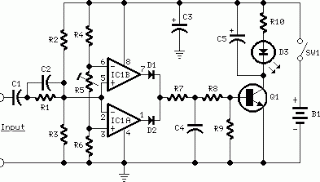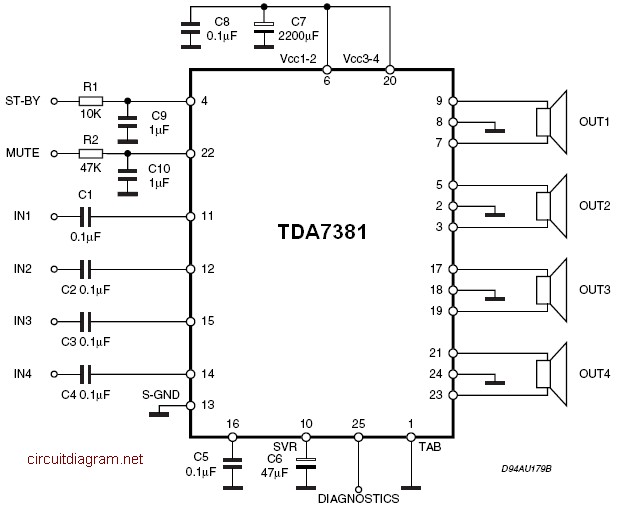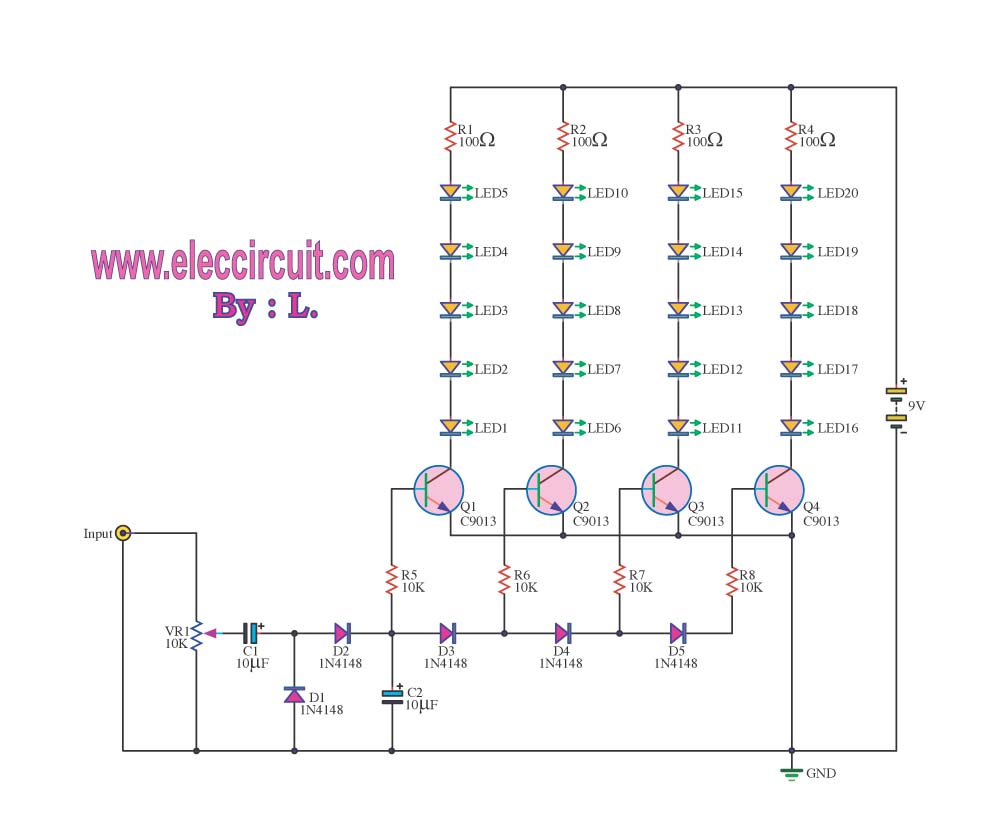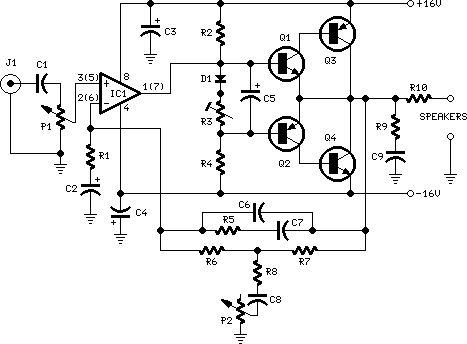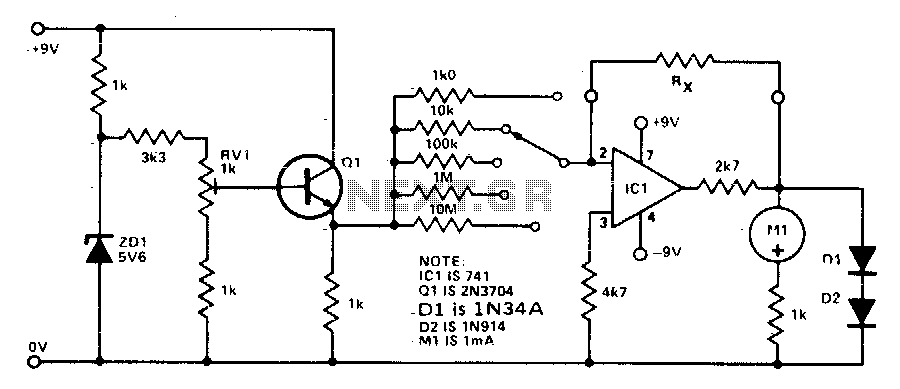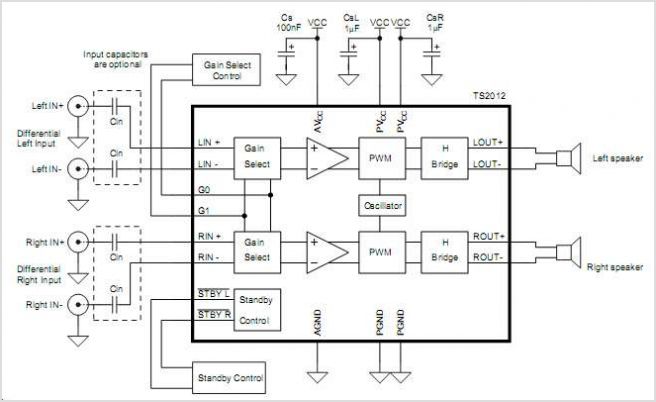
Audio Decibel Level Meter
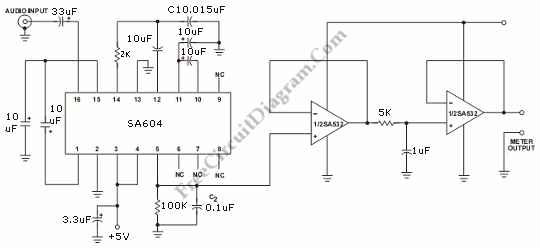
This circuit is an Audio Decibel Level Meter that utilizes the SA604 integrated circuit, which is designed as an RF device and also serves as a Received Signal Strength Indicator (RSSI). In cellular radio applications, the radio's microcomputer continuously monitors the received signal strength using this function. The circuit provides a logarithmic response that is proportional to the input signal level. The SA604 can deliver a logarithmic response over an 80dB range, operating up to a frequency of 15MHz. To construct a sensitive audio level indicator circuit, two integrated circuits, the SA532 and SA604, are employed. This circuit operates with a power consumption of less than 5mA using a single 6V power supply, making it suitable for portable battery-operated devices. Key advantages of this circuit include a sensitivity of 10.5mV, low power consumption despite an 80dB dynamic range, and a compact size.
The Audio Decibel Level Meter circuit is designed to measure sound levels and provide an output that corresponds to the decibel level of the audio signal. The core of this circuit is the SA604, which functions effectively as an RF device and RSSI, making it capable of processing audio signals with high precision. The logarithmic response characteristic allows the circuit to handle a wide dynamic range, accommodating variations in audio signal strength without distortion.
The SA532 integrated circuit complements the SA604 by enhancing the overall sensitivity and performance of the audio level meter. The combination of these two ICs enables the circuit to achieve a remarkable sensitivity of 10.5mV, which is essential for accurately detecting low-level audio signals. The low power consumption of less than 5mA is particularly advantageous for portable applications, allowing the circuit to operate efficiently on a single 6V power supply. This feature is critical for battery-powered devices, ensuring prolonged usage without frequent battery replacements.
The compact size of the circuit makes it suitable for integration into various portable audio equipment, such as handheld audio analyzers and sound level meters. The design can be further enhanced with additional components, such as filters or amplifiers, depending on the specific application requirements. The circuit's versatility in handling audio signals over an 80dB dynamic range up to 15MHz makes it an excellent choice for both consumer and professional audio applications. Overall, the Audio Decibel Level Meter circuit represents a practical and efficient solution for monitoring audio levels in a variety of settings.This is a circuit of Audio Decibel Level Meter. This circuit uses the SA604 which not only designed as an RF device but also the Received Signal Strength Indicator (RSSI). In a cellular radio, the radio`s microcomputer uses that function to monitor the received signal strength continuously.
A logarithmic response proportional to the input signal l evel is given by this circuit. The logarithmic response that can be provided by The SA604 is over an 80dB range up to a 15MHz operating frequency. Here is the circuit : To build a sensitive audio level indicator circuit, we can uses two integrated circuits: the SA532 and SA604.
This circuit requires less than 5mA with a single 6V power supply. So it is ideal for portable equipment that use battery as power supply. This circuit has some advantages such as 10. 5mV sensitivity, low-power consumption belie the 80dB dynamic range, and has small size. 🔗 External reference
The Audio Decibel Level Meter circuit is designed to measure sound levels and provide an output that corresponds to the decibel level of the audio signal. The core of this circuit is the SA604, which functions effectively as an RF device and RSSI, making it capable of processing audio signals with high precision. The logarithmic response characteristic allows the circuit to handle a wide dynamic range, accommodating variations in audio signal strength without distortion.
The SA532 integrated circuit complements the SA604 by enhancing the overall sensitivity and performance of the audio level meter. The combination of these two ICs enables the circuit to achieve a remarkable sensitivity of 10.5mV, which is essential for accurately detecting low-level audio signals. The low power consumption of less than 5mA is particularly advantageous for portable applications, allowing the circuit to operate efficiently on a single 6V power supply. This feature is critical for battery-powered devices, ensuring prolonged usage without frequent battery replacements.
The compact size of the circuit makes it suitable for integration into various portable audio equipment, such as handheld audio analyzers and sound level meters. The design can be further enhanced with additional components, such as filters or amplifiers, depending on the specific application requirements. The circuit's versatility in handling audio signals over an 80dB dynamic range up to 15MHz makes it an excellent choice for both consumer and professional audio applications. Overall, the Audio Decibel Level Meter circuit represents a practical and efficient solution for monitoring audio levels in a variety of settings.This is a circuit of Audio Decibel Level Meter. This circuit uses the SA604 which not only designed as an RF device but also the Received Signal Strength Indicator (RSSI). In a cellular radio, the radio`s microcomputer uses that function to monitor the received signal strength continuously.
A logarithmic response proportional to the input signal l evel is given by this circuit. The logarithmic response that can be provided by The SA604 is over an 80dB range up to a 15MHz operating frequency. Here is the circuit : To build a sensitive audio level indicator circuit, we can uses two integrated circuits: the SA532 and SA604.
This circuit requires less than 5mA with a single 6V power supply. So it is ideal for portable equipment that use battery as power supply. This circuit has some advantages such as 10. 5mV sensitivity, low-power consumption belie the 80dB dynamic range, and has small size. 🔗 External reference
